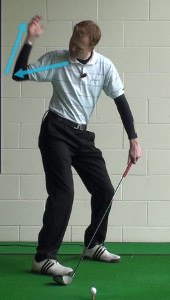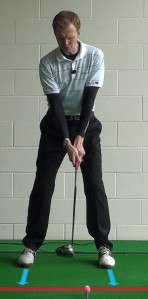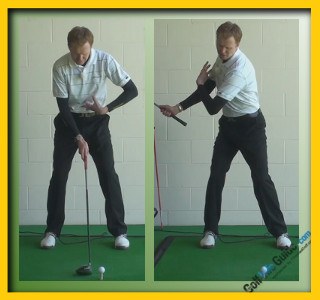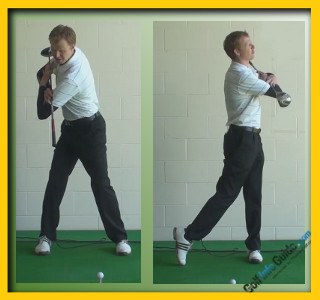
Quiz time: Who is the only current PGA Tour player, besides Tiger Woods, to win both the Masters and U.S. Open? Give up? It's Angel Cabrera, the big-hitting Argentine who took the green jacket in 2009, two years after his breakthrough victory at the U.S. Open.
Despite his major success, Cabrera remains relatively unknown among American golf fans. That's too bad, because his story is quite inspiring. Cabrera took up the game at age 10, walking six miles round trip to the nearest course. He finally got his own clubs at age 16, and turned pro just four years later.
Cabrera is a bit of a throwback to the pros of old, who learned to swing without guidance from highly paid instructors. In fact, Golf Digest called Cabrera “the last of the true caddie-yard players.” That was meant as a compliment, of course, and there's plenty to learn from Cabrera's natural action.
Cabrera's signature: Takes a free-wheeling rip at the ball while maintaining great balance and rhythm.
Who else does it: John Daly, Gary Woodland
Cabrera is a big fellow – about 6-feet tall and more than 200 pounds. He makes a huge backswing turn with his powerful upper body while his lower body remains “quiet,” or stable.

There are a couple of unusual aspects to Cabrera's swing that some instructors would look to fix. For one, he makes a more lateral movement to the right (backswing) and left (downswing) than is typical for a tour pro. For another, the angle between his right forearm and upper arm is considerably tighter than the standard 90°.
Why it works for Cabrera: Golf is hard enough without a lot of swing thoughts swirling in your head, right? Cabrera has a single goal each time he takes it back: a square clubface at impact. That's one reason he's able to swing so naturally, without concern for technical details.
Of course, whether consciously or not, Cabrera must compensate for his extreme right elbow position. He does so with a marked rotation of his right hip on the downswing, which pulls the right arm around and in front of his body. (A right arm that is “stuck” behind the body on the downswing can cause all kinds of problems, including pushed shots and hooks.)
Cabrera is extremely strong and flexible, especially in the arms and shoulders. His swing is built around these muscles, which produce clubhead speeds of up to 125 mph with the driver.
How it can work for you: If your setup fundamentals are sound, there's no reason not to take a good, full swipe at the ball. That's not to suggest that you should come out of your shoes on every drive; just swing at the maximum force you can achieve while maintaining balance and rhythm.

A good setup positions you to achieve correct hip and shoulder rotation and swing plane. Follow these fundamentals to a solid address with the driver:
- Feet at shoulder-width apart (insteps aligned with outsides of shoulders), or slightly wider.
- Right foot square or perpendicular to the target line.
- Left foot flared a little toward the target.
- Knees flexed comfortably.
- Weight distributed evenly between the heels and balls of your feet.
- Slightly more weight on your right side (for righties).
- Ball positioned off the left heel.
- Hands even with the clubhead.
Now do as Angel does and let 'er rip!

Angel Cabrera – Free Swing Stay Grounded Fundamentals
Angel Cabrera has long been one of the most popular players on the world golf stage. A highly accomplished player, Cabrera has two major championship titles to his credit, those coming at the 2007 U.S. Open, and the 2009 Masters. In addition to his tremendous play, Cabrera is also well-liked by fans and other players thanks to his easy going style and personality. Having turned professional all the way back in 1989, Cabrera has logged a long and impressive career which has netted him a total of 52 professional wins around the world.
One of the many elements of Cabrera's game that has won him fans around the world is the aggressive and free-flowing nature of his swing. When Cabrera stands over the ball, you can expect to see a swing that appears to be free from stress and yet full of power. In his day, Cabrera was one of the longest hitters on the PGA Tour – and he still can blast it out there with the young guns, even in his mid-40's. Rather than making a robotic swing which moves from one position to the next in a step-by-step fashion (like many of the young players today), Cabrera allows his swing to flow smoothly while relying on his beautiful rhythm to deliver the club at precisely the right moment. The swing looks casual, but it is incredibly consistent and effective.
Even in a 'casual' golf swing such as the one used by Angel Cabrera, there are still plenty of fundamentals and mechanics in place. One of the keys to Cabrera's swing is his ability to stay grounded from takeaway all the way through to the finish. Many players, in an effort to hit the ball as hard as possible, come up off of the ground slightly during the downswing, leaving only their toes in contact with the turf. That is not the case in Cabrera's swing. Rather, his feet are incredibly quiet and controlled, while the club whips around his body and launches the ball into the distance. There is no doubt that a large portion of Cabrera's success over the years can be attributed to his excellent footwork during the swing. It is hard to deliver the club consistently to the back of the ball when your feet are moving all over the place, so take a cue from Cabrera and work on staying grounded as completely as possible.
It should be noted that 'staying grounded' does not mean you have to make a short or conservative swing – certainly, that is not the case with Angel Cabrera. Cabrera makes a rather long swing, with the club traveling well past the parallel position at the top (with the driver, specifically). You should think about your feet during the golf swing in the same way that you think about the tires on your car. Sure, it is the engine that actually makes your car move, but you wouldn't get anywhere safely if your tires were jumping all around and leaving the surface of the road. Keep your feet on the ground just like you keep your car tires on the road, so that your body rotation (the engine of your swing) can do its job successfully.
All of the content below is based on a right handed golfer. If you happen to play left handed, please take a moment to reverse the directions as necessary.

Benefits of Staying Grounded
If you take a look around at the other golfers hitting balls at your local driving range on a Saturday afternoon, you will likely find that most amateurs have trouble staying grounded during the swing. It is tempting to come up onto your toes as you swing down, as it feels like more power will be generated with that move as compared to keeping your feet down flat. However, most golfers will actually be able to achieve more swing speed if they stay grounded, and the quality of their ball striking will improve as well. If you have been looking for a way to take a big step forward in your game, learning how to stay grounded throughout the swing is a great place to start.
Following is a list of benefits that you can enjoy if you learn how to stay grounded all the way through impact and into your finish position.
- Improved rotational speed. The golf swing is all about rotation. If you want to hit the ball long distances, you need to be able to rotate your body rapidly toward the target – it really is that simple. Unfortunately, if you allow your heels to come up off the ground during your downswing, you will actually be working to slow down the rotation of your body. Any movement that you make in an upward direction is going to take away from your rotation to the left, meaning your swing will be slower as a result. To permit your body to turn left as fast as possible, you want to keep your feet flat on the ground all throughout the swing.
- Consistent ball striking. The biggest challenge that you face in the game of golf is contacting the back of the ball with the sweet spot of your club. There are a lot of other things on the golf course to distract you along the way, but this is really what the game is all about – if you can hit the sweet spot time after time, you are going to play at a relatively high level. To make that task easier, it is important that you stay grounded and keep your body at a steady level during the swing. Moving up and down will only serve to make it more difficult to strike the ball cleanly – and golf is not a game that needs to be made any harder than it already is. With quiet feet and a stable head, you will be giving yourself the best possible chance to find the sweet spot time after time.
- Stability throughout the course. As you already know, you don't always draw a great lie on the golf course. Often, you will be standing on some degree of slope while you are trying to hit a shot. Sometimes, you will have to deal with wet grass, and some shots will be played from surfaces like sand or even gravel. The point is this – you can't count on great footing each and every time you swing the club. With that in mind, you will find that you have greatly improved stability during your swing if you are able to stay grounded. The possibility of slipping during the swing will be reduced if you keep your feet flat on the ground, meaning you can swing with more confidence than you could if you were moving all around while trying not to lose your balance. To prepare yourself for all of the challenges that lay ahead on the golf course, it is advisable to keep your feet as quiet as you can.
The list above includes the three biggest benefits that you will enjoy when you keep your feet grounded during the golf swing – but there are likely to be others, as well. It should be clear by now that it will be worth your time and effort to learn how to keep your feet down flat on the ground while the club moves through impact. Opportunities to improve both your power and the consistency of your ball striking by making a simple swing change are hard to come by, so you have to look into them when they do come around. Also, unlike other swing changes, this is an adjustment that shouldn't take a prolonged period of time to make. After just a quick practice session or two, you may find that your ball striking is already moving in the right direction.

Checking on Your Footwork
If you have previously ignored this area of your game, you might not even know what is going on with your feet in the current version of your golf swing. Before you can work on improving your footwork, it will be necessary to check on their current behavior in both the backswing and downswing. After all, if your feet are already quiet throughout the swing, you don't have to worry about working on this point. You don't want to spend time trying to fix something that is broken, so make sure you actually have a problem in your footwork before you bother trying to make changes.
The best way to check on your footwork is through the use of video. While you can try to 'feel' how your feet are moving throughout the swing, your own personal feel can lie to you from time to time. On the other hand, the video will never lie. Ask a friend at the driving range to record you while making a couple of swings. For this purpose, hitting shots with your driver will be best, as the driver is the club most likely to cause poor footwork. After a couple of swings have been recorded, take a moment to review the video and see what is really going on with your feet.
There are a couple of points during the swing that you want to check on specifically when it comes to your footwork. The first is the transition from backswing to downswing. When the club starts to change directions at the top, what happens to your feet? Do they remain flat on the ground while your hips start turning toward the target, or do they push up off the ground? Obviously, you want to see them staying down while you get your turn started effectively. If you are pushing up onto your toes immediately upon the start of the transition, you will need to work on making some mechanical adjustments.
The other point you need to look for on your video is right before the club arrives at impact. If possible, watch your swing in slow motion to get a good idea of how your feet are moving at this point in the swing. If slow motion isn't an option on your video player, at least pause the video a few times during the downswing to get a good look at what is taking place in your footwork. Again, you are hoping to see nothing at all. Your swing should be continuing freely to the left while your feet remain flat on the ground (the left foot is likely to roll out to the left slightly through impact, but that is okay). Just as in the transition, if you see your feet pushing off of the ground prior to impact to the point that your heels leave the turf, you are going to need to spend some practice time fixing that mistake.
Using video is a great way to quickly analyze your swing before getting started on any technical changes. It only takes a few moments to record a swing video, yet the information that is gained in those moments can go a long way toward making you a better player. In this case, you will be able to get a great look at the current state of your footwork, and you can move forward from there knowing what changes are needed to keep your swing nicely grounded from start to finish.

Your Legs Still Drive the Swing
One of the risks that you run when trying to keep your feet quiet throughout the golf swing is that you might take it too far and wind up with your legs staying quiet as well. The lower body plays a crucial role in your golf swing, and it is critical that your hips and legs turn aggressively toward the target as the club comes down. The majority of your power comes from your lower body in golf, so don't make the mistake of keeping your legs out of the swing. It is true that you want to keep your feet grounded, but that will only help you achieve great ball striking if you are still able to turn your legs hard through the hitting area.
You can see this concept demonstrated perfectly in the swing of Angel Cabrera. While Cabrera keeps his feet nicely on the ground at impact, his hips have turned hard through the ball and are pointing out in the general direction of the target. If you are going to harness all of the power that you are capable of generating in your swing, it is essential that you match this kind of movement. Keeping your feet flat on the ground while your legs fire through the shot might seem difficult, but it is a movement that will become far more natural with time and practice.
To use your lower body effectively in the swing, the first thing you need to do is get your legs started immediately upon the backswing turning to the downswing. As your top of the swing transition is taking place, your lower body should be beginning its turn toward the target. Failing to start the lower body turn in time is one of the top mistakes made by amateur golfers. Once your arms and the club get started moving down toward the ball, it will be too late for your lower body to do the same. You have to get out in front of the swing with your lower body or you will be stuck behind all the way through the shot. If there is one single reason why amateur golfers cannot hit the ball as far as their professional counterparts, it is this – the late movement of the lower body in the downswing.
In order to use your legs effectively in the swing, and to keep your feet grounded properly, it is important to flex your knees at address. With a comfortable amount of knee flex in place before you start your swing, you should be able to keep your legs engaged in the action from start to finish. If you can arrive at the top of the swing with your knees flexed, it will be far easier to get your lower body moving to the left properly. Many amateur golfers stand over the ball with their legs locked out totally straight – a position which makes it nearly impossible to use the lower body effectively coming into impact. The knee flex that you use at set up should carry all the way throughout the backswing and downswing, with your left leg only straightening up as you swing through the shot and into the finish.
Using your legs as a major power source in your golf swing is crucial to reaching your power potential. Simply put, you aren't going to be able to hit the ball long distances on a consistent basis without putting your lower body to use. Only when you can combine the ability to keep your feet grounded with the ability to use your legs aggressively are you going to truly achieve powerful and accurate ball striking performance.

Lower Body Silence in the Short Game
Angel Cabrera didn't win two majors, along with a long list of other professional titles, with his full swing alone. Every professional golfer needs to have a solid short game, and Cabrera possesses a great touch to go along with his impressive power. If you are going to take your game to the next level of performance, you need to not only be able to hit long and straight shots, but you need to have the short game to go with those shots. Working hard on your long game only to neglect your short game just doesn't make any sense – it is the well-rounded golfer who will prevail at the end of the day.
When it comes to footwork in the short game, you shouldn't have any. It's just that simple. While hitting your putts or short chips and pitches, your feet should be completely quiet throughout the swing. You don't need to generate power for these short shots, so your legs should be quiet as well. The arms are more than capable of handling this shot on their own, as long as you swing the club through freely and make great contact. Moving around with your lower body is only going to complicate the swing, which is the last thing you want to do as you get close to the hole. Work on staying totally stable from the waist down on your short shots and your performance should improve almost immediately.
One good way to work on the stability of your lower body in the short game is to focus on the position of your knees. During your next trip to the practice area at your local golf course, set a few balls down on the green just a few feet from a hole. While hitting these practice putts, focus on the position of your knees throughout the stroke. Ideally, both knees will remain perfectly still from the time you start the stroke until the ball falls into the cup. If you are having any trouble with the stability of your lower body, you will find that at least one of your knees moves at some point during the stroke (likely during the transition from backstroke to forward stroke). Continue to work on holding your knees perfectly still while you putt, until you get comfortable with the feeling of using only your arm swing to hit the ball.
Angel Cabrera is one of the most-accomplished golfers in the world, and he owes much of that success to the way he stays grounded through the swing. Even though he makes a big swing and is capable of big power, he still keeps his feet nice and quiet as he moves through the hitting area. Every golfer, from the total beginner to the accomplished tournament player, can learn from this example. Work on keeping your feet grounded throughout the golf swing and you will become a better ball striker as a result.





